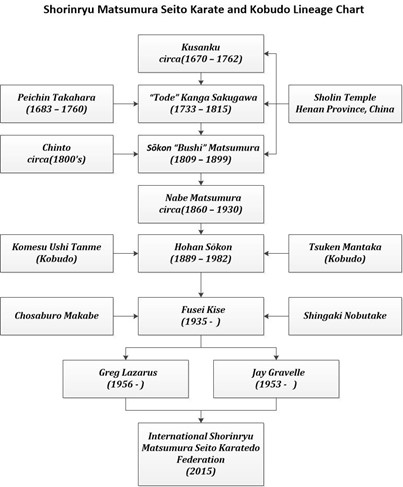
History of Karate and Kata
A lot has been written about the origins and history of karate and a lot of it has been passed down through the ages through stories both verbally and writings. Some of it true and some of it told through the eyes of people wanting it to be true.
Although not officially called karate, “Empty hand” techniques have been around since the beginning of time. Evidence of this is found throughout the centuries. Cave drawings and ancient Egyptian drawings show aspects of martial arts from thousands of years ago in both empty hand (karate) and using weapons (kobudo). It is safe to say the origins of karate started around the beginning of time.

Dendera-Nubian Martial Arts Hieroglyphics
on the wall of temple of Ramses III dating back to around 1080 BCE
Permission was given for the use of the image at Wikimedia Commons
In tracing the history of Shorinryu Matsumura karate there are a lot of different thoughts. Any written history has been lost though out time between the many destructions of the Shaolin Temple and in Okinawa during World War two. It is up to everyone to do their own research and make up their own mind, as the history of karate has been passed down through time mostly verbally through stories. As what happens over time, sometimes the stories have been embellished to the point it’s hard to tell what is fact and what is fiction. There are many people over time who played key roles and contributed to Shorinryu Matsumura karate. The following are people who we consider to be the direct lineage for the ISMSKF. As such, there are several people who have been left out . This is the most logical history for Shorinryu Matsumura Seito Karatedo.
Bodhidharma
It is well believed Bodhidharma was the first person most people hear of using some form of karate. There is a lot of debate as to where in India Bodhidharma came from and when he first went to the Shaolin Monastery in China. Bodhidharma was most likely from the region of southern India and arrived at the Shaolin Monastery sometime in the 5th or 6th century.
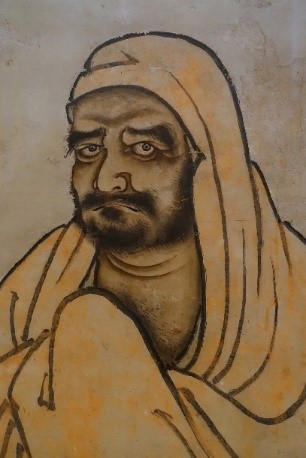
Bodhidharma by Unkei Ikkei, Japan, 1504-1520 AD
ink on paper, detail – Linden-Museum – Stuttgart, Germany
Permission was given for the use of the image at Wikimedia Commons
Shaolin legends say Bodhidharma was concerned with the weak physical condition of the Shaolin Monks at the monastery and started training the monks in the martial arts. Unfortunately, the Shaolin Temple has been destroyed and rebuilt many times throughout the years. Although there have been some writings attributed to Bodhidharma and what he taught, most of those were written hundreds of years after he was there, and I am afraid any original writings or history were lost long ago. Suffice it to say the Shaolin Monks have perfected and expanded the teachings and are some of the basis of modern-day karate.
Prior to the Shaolin teaching reaching the Ryukyu Islands (Okinawa being the largest of these) the Ryukyuan practiced a martial art known as Te. There were not any formal systems during this time, and these were passed down within families and close members of villages. During the 14th century trade was established between the Ryukyu Islands and China. With this, people moved back and forth and exchanged knowledge and arts including the fighting methods from China and the Shaolin Temple.
With the banning of weapons by Okinawan King Shō Shin in the 15th century and the Japanese Shimazu clan in the 17th century empty hand techniques became even more important to learn and develop to protect oneself from advisories and bandits on Okinawa. Most of these techniques were still only passed on to family members and close friends. There was and still is a veil of secrecy within the Okinawan martial arts. By the 18th century the Okinawan martial arts were known by several different names including adding te to the end of different villages such as Okinawa-te, Naha-te, Shuri-te and Tomari-te. Being a mix of both te and Chinese martial arts were sometimes called tuide or tode.
The history of Shorinryu Matsumura family karate is attributed to several martial artists over the years.
Kūsankū circa (1670 – 1762)
During the mid-1700’s Kūsankū, a Chinese emissary, and some of his students travelled from China and lived for about six years in an area around Naha, Okinawa. Kūsankū had trained under a Shaolin monk in China and was renowned for his fighting on Okinawa. Not much is known about Kūsankū, but he is famous in our style of teaching an Okinawan by the name of Kanga Sakugawa. Kūsankū returned to China after staying in Okinawa for six years.
“Tode” Kanga Sakugawa (1733 – 1815)
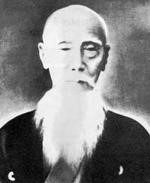
Portrait of Kanga Sakugawa at an elder age.
Permission was given for the use of the image at Wikimedia Commons
Sakugawa started his early training with an Okinawan, Peichin Takahara, said to be a monk and map maker born around Shuri, Okinawa. Sakugawa was introduced to Kūsankū and studied with him for the six years Kūsankū was in Okinawa. After Kūsankū returned to China Sakugawa travelled several times to China and continued his study with Kūsankū. The Kūsankū kata was developed by Sakugawa as a tribute to his teacher Kūsankū. Sakugawa is also credited with passing on the Hakutsuru (White Crane) kata from the Chinese Shaolin system. Although truly little is known about Sakugawa he was so well known he was called “Tode” which is also referred to as a name precursor to “karate.” Kanga Sakugawa is known as the “father” of modern karate and his most famous student for our style was Sōkon “Bushi” Matsumura.
Kata Created: Kusanku
Kata Passed On: Hakutsuru
Sōkon “Bushi” Matsumura (1797 – 1899)

Only known picture of Sōkon “Bushi” Matsumura
Permission was given for the use of the image at Wikimedia Commons
Sakugawa was an old man by the time Sōkon Matsumura started his training and Sakugawa was reluctant to train him. Fortunately for our style Sakugawa agreed to train Matsumura.
By the time Sōkon Matsumura was 20 years old he had gained a reputation for his karate throughout Okinawa. Matsumura was recruited into the service of the Okinawan Shō royal family. Many things have been written about his exploits in the service of the royal family. During this time, he travelled several times to China and Shaolin Temple to train is the White Crane system. Upon his return to Okinawa, he is credited with systemizing the Shuri-te style of karate. Later naming it Shorin after the Shaolin temple meaning “Pine Forest.” He is said to have never lost a contest and was the last known Okinawan samurai to be awarded the title of “Bushi.” He married Yonamine Chiru, a martial artist in her own right including putting Matsumura in his place, unbeknown to her. Although much is unknown about Yonamine Chiru there are several stories about her, and several kata are attributed to her influence in Shorinryu Matsumura.
“Bushi” Matsumura is credited with creating many of our kata including Passai, Naihanchi 1 and 2, Seisan, Chinto, Gojushiho and passing on Kusanku and Hakutsuru from Sakugawa. One of Matsumura’s students, Ankō Itosu, is credited for creating Pinan 1 and 2 and Matsumura also passed those on for our system. Bushi Matsumura trained several famous students, most notably for our system of Shorinryu Matsumura is his grandson, Nabe Matsumura.
Kata Created: Passai, Naihanchi 1 and 2, Seisan, Chinto, Gojushiho
Kata Passed On: Kusanku and Hakutsuru and From Ankō Itosu: Pinan 1 & Pinan 2
Nabe Matsumura (1860 – 1930)
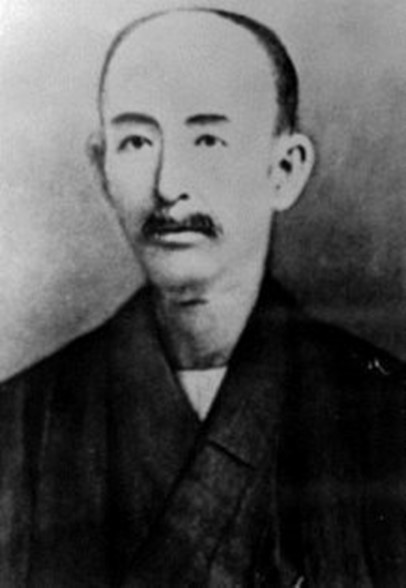
Historical photo of Nabe “Old Man Nabe” Matsumura
Not much is known about Nabe Matsumura and even the dates of his birth and death are in debate. In Okinawa there are different names that might be assigned over their lifetimes and with Nabe Matsumura it was no different. Nabe was also known to be called several other names including Nape no Tanme meaning “Old Man Nabe.”
Bushi Matsumura taught two different styles of karate. One that was taught to only family members and one that was taught to non-family members. Being Bushi Matsumura’s grandson, Nabe Matsumura was taught the family system and is said the only person Bushi Matsumura taught the Hakutsuru (White Crane) kata. Nabe Matsumura was said to only teach family members and the only known student he taught was his nephew Hohan Sōkon who received the Menkyo Kaiden.
Kata Created: None known
Kata Passed On: Passai, Naihanchi 1 and 2, Pinan 1 and 2, Seisan, Chinto, Gojushiho, Kusanku and Hakutsuru
Hohan Sōkon (1889 – 1982)
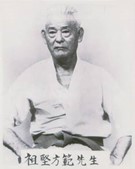
Historical photo of Hohan Sōkon
Hohan Sōkon was the founder of Shorin Ryu Matsumura Seito (Orthodox) Karatedo and one of the greatest karateka of all time and later in life, designated as one of Japan’s living national treasure. He was the last of the samurai and was born during the time of great upheaval in Okinawa, both political and of natural disasters. This was a time of great transition from the old ways to the “new” modern ways. From his days as a young boy instead of being raised as a samurai Hohan Sōkon worked in the fields. Hohan Sōkon began his karate training at age 13 under his uncle Nabe Matsumura. At age 23 Nabe Matsumura started teaching Sōkon the coveted secrets of Hakutsuru.
During the time of Sōkon’ s young adulthood there were very hard times on Okinawa and in 1924 Sōkon, along with many other Okinawans emigrated to Argentina, near Buenos Aires. During his time in Argentina, he worked as a photographer and in the clothes cleaning business. Not much is said about his teaching karate or any of his students in Argentina, but it is known he did many demonstrations while he was there.
During his time in Argentina there were many changes on Okinawa. With the inclusion of karate in mainland Japan, karate, on Okinawa became more sport oriented. During World War II and the devastating Battle of Okinawa many karateka lost their lives, and many dojos and records were destroyed. When Hohan Sōkon returned to Okinawa in 1951 he was extremely disappointed at the changes to karate and refused to change his teachings or join other karate associations. He named his karate Matsumura Seito (Orthodox) Shorin-ryu Karatedo and Hohan Sōkon passed on many of the kata we practice today including Naihanchi 1 & 2, Pinan 1 & 2, Seisan, Passai Sho & Dai, Chinto, Gojushiho, Kusanku, Rohai and Hakutsuru and taught Kobudo with Bo, Sai, Kama, Tonfa, Nunchaku, Kusarigama and Surchin. Fusei Kise worked with Hohan Sōkon and created additional kata including Naihanchi 3 and Pinan 3, 4 & 5 along with several Kobudo katas.
Hohan Sōkon taught many Okinawans, American and other students. Fusei Kise was his most notable student and received the Menkyo Kaiden.
Kata Created: Rohai,
Kata Passed On: Passai Sho & Dai, Naihanchi 1 and 2, Pinan 1 and 2, Chinto, Gojushiho, Kusanku and Hakutsuru, and several Kobudo katas. With Fusei Kise: Naihanchi 3 and Pinan 3, 4 & 5, from Tsuken Mantaka: Tsuken (Chikin) bo
Fusei Kise (1935 – )
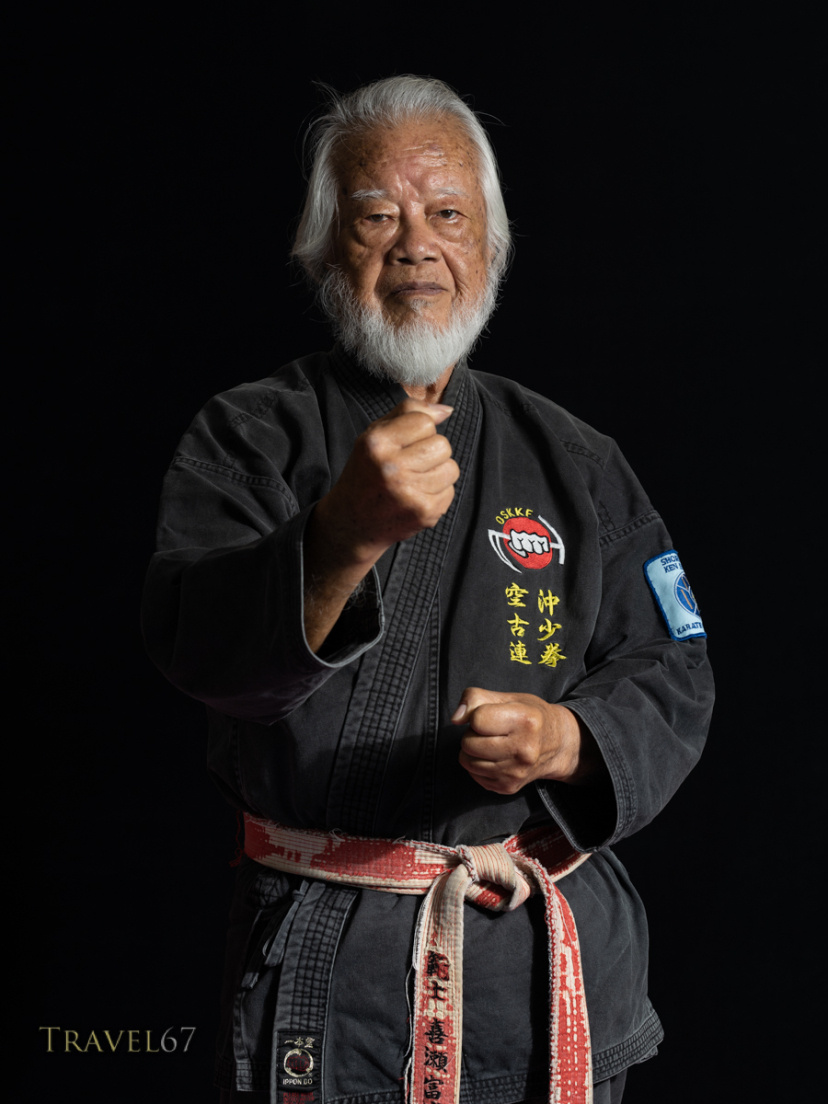
Fusei Kise taken in Dover New Hampshire,
copyright by Greg Lazarus
Permission was given for the use of the image from Greg Lazarus
Fusei Kise’s training in karate included a variety of sensei. He began his training in karate at the age of twelve under his uncle Chosaburo Makabe. During this time Okinawans were encouraged to study under different sensei to get proficient in karate in general. Fusei Kise understood this and took full advantage. At different times during his early years, he would study under more than one sensei at the same time. Fusei Kise studied under Shingaki Nobutake, Shigeru Nakamura, Shinbu Arakaki, Zenryo Shimabukuro and Hohan Sōkon. At the age of 20 Fusei Kise received his Shodan from Sensei Shingaki and at age 23 was awarded his Yondan from Sensei Shimabukuro. In 1955 Kise became a student of Hohan Sōkon where he was first introduced to Sōkon’s Matsumura Seito Shorin-ryu Karatedo. In 1965 he was promoted to 7th Dan by Sensei Nakamura, founder of Okinawan Kenpo Karatedo Federation and was promoted to 7th Dan and awarded the title of Shihan. Fusei Kise was also studying under Hohan Sōkon and was promoted to 7th Dan in Hohan Sōkon’s Matsumura Seito Shorin-ryu Karatedo in 1967. In 1972 Fusei Kise was promoted to 8th Dan by Hohan Sōkon and then promoted to 9th Dan in 1976 by Hohan Sōkon and Kazuo Futenma of the Ryukyu Karatedo Institute. In 1977 Fusei Kise founded the Okinawa Shorinryu Kenshin Kan Karate and Kobudo Federation. In 1987 Fusei Kise was promoted to 10th Dan by Sakae Tamae of the All Okinawa Shorin-ryu Karatedo & Kobudo Federation. In 2001 the Japanese Seal of Approval for the accuracy of Fusei Kise’s book “The Spirit of Okinawan Karate” was entered into the Japanese Government Archives. and it was stated Fusei Kise is the sole true heir to Shorinryu Matsumura Seito Karate that was passed down to him by Hohan Sōkon. In April of 2001, the Japanese Parliament honored him with a prestigious Lifetime Achievement Award in Naha, Okinawa.
Sometime around the 1970’s under the guidance of Hohan Sōkon, Fusei Kise created Naihanchi 3 and Pinan 3, 4 & 5, and many Kobudo kata. It is unclear as to which kata were first learned, modified, or created by Fusei Kise and Hohan Sōkon, as both have said they learned katas from other teachers.
Author’s Notes: With a lot of the old records of karate being destroyed or lost over the years there is much of the history of karate that is hearsay and legends. In researching the history of lineage there are many times I found conflicting information and did my best to relay what I see as the closest to the truth. I found even conflicting information in Master Kise’s books, “The Spirit of Okinawan Karate” by Fusei Kise and “Okinawa Karate-Do” by the Okinawa Shorin-Ryu Matsumura Seito Karate Kobudo Federation. These both conflict with many versions of his history on websites across the internet.
One thing left out and I was privy to was in 1977 only by virtue of my being in Okinawa at the time was a falling out between Master Kise and Master Sōkon. This was caused by a disagreement when Master Kise was in the United States and Master Sōkon took it upon his self to renew the base agreement for Master Kise. This was an agreement that needed to be signed right away for Master Kise to keep teaching on the American bases on Okinawa. Sōkon thought he was doing the right thing. I only mention this because it was in 1977 that Master Kise founded the Okinawa Shorinryu Kenshin Kan Karate and Kobudo Federation and in my belief, it was not due to the reasons stated elsewhere, but because of the falling out between Master Kise and Master Sōkon. I left Okinawa in December of 1977 and do not know what happened after that time on Okinawa, however their relationship was repaired before Master Sōkon passed away in 1982.
Kata Created: With Hohan Sōkon: Naihanchi 3 and Pinan 3, 4 & 5, and many Kobudo kata
Kata Passed On: Rohai, Passai Sho & Dai, Naihanchi 1 and 2, Pinan 1 and 2, Seisan, Chinto, Gojushiho, Kusanku and Hakutsuru, Naihanchi 3 and Pinan 3, 4 & 5, Tsuken (Chikin) bo, and several Kobudo katas. From Shorinjiryu: Wansu, Ananku, and Seisan.
